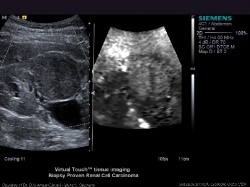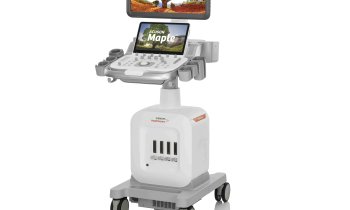MEDICA 2013
We have entered ultrasound’s renaissance period
ARFI technology lowers liver biopsy rates and soon will do far more
An innovative technology is enabling radiologists to provide more accurate diagnoses.


Virtual Touch is easy to use he added. ‘It gives you more confidence in the assessment of liver diseases. With experience, you have enough knowledge to understand when a liver may be diseased and can infer that it is perhaps fibrosed or cirrhotic but now we have a tool that canquantify that and objectively give the answer.’ Meanwhile, in France, Dr Corinne Balleyguier from the Department of Radiotherapy at the Institut de Cancérologie Gustave Roussy, is using Virtual Touch IQ (VTIQ) daily for breast imaging. Beginning with analysis on B-mode imaging in breast ultrasound, she uses VTIQ with the colour map of speed in the tissue and adjacent breast tissue, followed by a quantification of shearwave speed in tissue and normal adjacent breast tissue. ‘This additional information of breast lesion stiffness, correlated to B mode features, she explained, ‘helps me to be more confident in my diagnostic decision, either for malignancy or to assess a benign lesion.’
Using VTIQ on an ACUSON S3000 ultrasound machine, this technology offers her ‘more functional information about breast lesion characteristics,’ Dr Balleyguier added. ‘VTIQ is more reproducible than other free-hand elasticity modes, and less dependent on the pressure applied with the ultrasound probe, which can be difficult to assess when we begin with elastography.’ The VTIQ technology makes her more confident in her diagnosis in breast ultrasound as well as in echoic cysts because it allows even better assessment of the cystic content, showing very slow speed measurements.
‘Now, we can reduce the use of fine needle aspiration in some particular cysts with benign findings on VTIQ,’ she explained. In solid lesions, from a personal study of 110 lesions including benign and malignant lesions, she told how B-mode imaging achieved 92% sensitivity and 62.5% specificity, with a diagnostic accuracy of 79.1%. Combined B-mode and VTIQ assessment of breast tissue abnormalities achieved an overall sensitivity of 90.3% and 75% specificity. That better diagnostic performance has reduced the use of unnecessary biopsy. There are also other advantages. ‘VTIQ now offers a very visual mode, easy to learn and to work with, which can be used in clinical practice,’ she said. ‘The colour map of shearwave is more likely to be used to obtain a quick analysis of a suspicious lesion and coloured map of stiffness may also be used to target the biopsy towards a more suspicious area of a lesion and to obtain a more representative sample.’ Currently focusing on the characterisation between benign and malignant lesions, a next step for Dr Balleyguier is the evaluation of treatment response after local treatment or neo-adjuvant chemotherapy.
Imaging and Quantification (VTIQ) as a new diagnostic tool in diseases of the superficial organs like breast, thyroid, lymph nodes and testes. Siemens Ultrasound CEO Jeffrey Bundy predicted that, in the not-toodistant future, Virtual Touch would be a ‘crucial component of general imaging ultrasound examinations’. In the past, he said, ‘an imaging modality just looked at structure and tissue interfaces but with Virtual Touch we are now able to look in the tissue and image structural changes within a tissue. This is able to give physicians new types of information.
‘With liver exams, providing physicians with the tools that enable them to bypass an invasive procedure and still make a confident diagnosis is extremely exciting for me as an imaging provider,’ he added. Siemens has launched several
new imaging products in the last 16 months. These include the higherend ACUSON S1000 and S3000 systems and ACUSON X700 system at a ‘very affordable price point’, and the ACUSON P300 system as a small portable hand carried unit, while the ACUSON Freestyle – the world’s first system with wireless transducers – is an innovation that has been requested by advisor groups for decades and is targeted in point-of-care space.
Dr Bundy commented: ‘We are in a very exciting business; it’s a growing market – not just in financial terms but also because of the adoption and use of technology. ‘Within the imaging world we can provide quick portable examinations at a reasonably low cost and with a lot of pressures on healthcare systems, we are right at the centre of what I consider
to be a “renaissance period” in ultrasound.’
The ACUSON S3000 system, in which Siemens has all its Virtual Touch capabilities, brings fusion MRI and CT images together with ultrasound images in a real-time setting through eSieFusion technology. Dr Bundy believes that Siemens
expects to grow ‘significantly faster than the market’, particularly in the area of Virtual Touch, automated quantification tools for cardiology, Freestyle and ABVS (Automated Breast Volume Scanner) with the ability to provide imaging for women with dense breasts with Siemens 3-D total breast ultrasound solution.
Siemens is also excited with the AcuNav line of products in the catheter market with an ultrasound transducer on the tip of a catheter, Dr Bundy added. ‘It’s a cardiac application, primarily in electrophysiology procedure guidance, but we are
starting to see some exciting exploration in minimally-invasive valve procedures.’
Siemens is at Medica Hall 10, booth A20.
Mark Nicholls reports
20.11.2013











